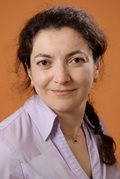Course report – Basic Clinical Radiobiology
9-13 September 2023, Porto, Portugal
PDF version
1) Could you please briefly introduce yourself?
My name is Aniko and I am a medical physicist currently working as a senior physics and application specialist at RaySearch Laboratories AB, stationed in Germany. I had long clinical experience in Norway that began in diagnostics after I finished my studies at the University of Oslo in 2000 and continued in radiation therapy from 2002 until I moved to Germany and joined RaySearch Laboratories in 2019.
2) Why did you choose to attend this course?
This was the second time I attended this course; the first was in 2004. I found that the knowledge I acquired that first time was very useful in my work at the clinic, as the typical phrase I heard from the oncologists was “You are a physicist, you can calculate this”. However, as the years passed, some of my knowledge seemed to be outdated. This fact became clearer to me in my current role, in which I give many lectures about particle physics, the relative biological effectiveness of the particles, linear energy transfer evaluation and optimisation, biological optimisation and evaluation, and the calculation of the equivalent dose in 2Gray fractions (EQD2), in which picking the value (the dose at which linear and quadratic components of cell killing are equal for a given tissue) is not trivial.
Also, the handling of retreatment is a big issue for many participants on the courses I teach. That is why I decided to attend this course again.
3) What aspects of the course were the most interesting and why?
First of all, knowledge of cancer genetics has evolved massively and hence, so has the way in which we can look at treatment regimes. This was certainly different back in 2004.
Also, the ‘dogmas’ about tissue seriality and the increased knowledge about sensitive areas of irradiated tissues, the stem-cell problem combined with the volume effect, plus the increased knowledge we have about the almost day-to-day variation in tumour hypoxia, made me rethink how we hunt for voxel dose distributions and how realisable it can be to turn to dose painting by numbers.
4) Did the course activities improve your knowledge and skills in the relevant subject?
The course has undoubtedly improved my knowledge; the teachers were highly skilled in their respective fields, and there was a lot to learn from them.
5) Did the course meet your expectations? If so, how?
Yes, the course lived up to my expectations. It was an eye-opener regarding many aspects of modern radiation therapy; starting with the failure of new combination-treatment trials to achieve what was hoped for, then some success stories, and then the increased role of hypo- or hyperfractionation in cases in which one or the other is useful.
I found also stem cell research very intriguing as well as the increased understanding of its role in the success and failure of the treatment.
For my part however, I would wish a bit more about the LET/RBE, as the clinics today, even with more and more knowledge about the topic, tend to hold on to the 1.1 with protons and the Chordoma cell type for the whole body for carbon treatment. And how to assess this with LET optimisation/evaluation might be of great importance, not least for the organs at risk, but also for the tumor control probability.
6) List the important takeaways following the course.
a. The increased insight into genetics and stem cell behaviour gives us the opportunity to tailor treatment for cancer patients, increasing the probability of problem-free long-term survival/tumor control.
b. The understanding of the balance between TCP/NTCP is inevitable in modern radiation therapy. Since cancer patients tend to live longer due to better treatment regimes, there should be even more focus on late effects and post-treatment quality of life.
c. Knowledge about a/b and tumour sensitivity, by going away from assuming, that every tumor comes with an a/b = 10, can make our treatment regimens even more effective. This is already benefiting large patient groups, e.g., breast and prostate cases are routinely hypofractionated due to the discovery that these tumor types express lower a/b values.
7) How what you have learned be implemented in your daily job/clinical practice?
I am not working in the clinic anymore; however, I do work with clinical staff. I will certainly use some of the knowledge in my future training in how I go through examples for both treatment optimization and not at least evaluation of treatment plans.
8) How would you encourage someone who has never been to an ESTRO Course to join this course next year/in two years?
I do believe that everyone involved in radiation therapy treatment should attend this course, as this gives an insight into the mechanisms that drive tumour control and what to look for when it comes to normal tissue complications. And even if you have been in the field for a long time, as I have been, it is never too late to learn something new and useful. And without the need to go through every article ever written about the topics, you are served on a silver platter everything that might be relevant to your clinical “life”.

Aniko Balazs
Senior physics and application specialist
RaySearch Laboratories AB
Forchheim, Germany
anibal@raysearchlabs.com